Hyundai Accent: ABS(Anti-Lock Brake System) / Troubleshooting
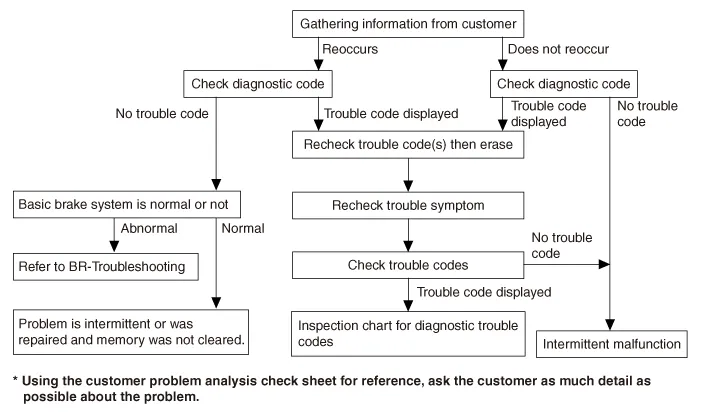
| Condition | Explanation | ||||||
| System check sound | When starting the engine, a thudding sound can sometimes be heard coming from inside the engine compartment. This is because the system operation check is being performed. | ||||||
| ABS operation sound |
| ||||||
| ABS operation (Long braking distance) | For road surfaces such as snow-covered and gravel roads, the braking distance for vehicles with ABS can sometimes be longer than that for other vehicles. Accordingly, advise the customer to drive safely on such roads by lowering the vehicle speed. | ||||||
| Diagnosis detection conditions can vary depending on the diagnosis code. When checking the trouble symptom after the diagnosis code has been erased, ensure that the requirements listed in "Comment" are met. | |||||||
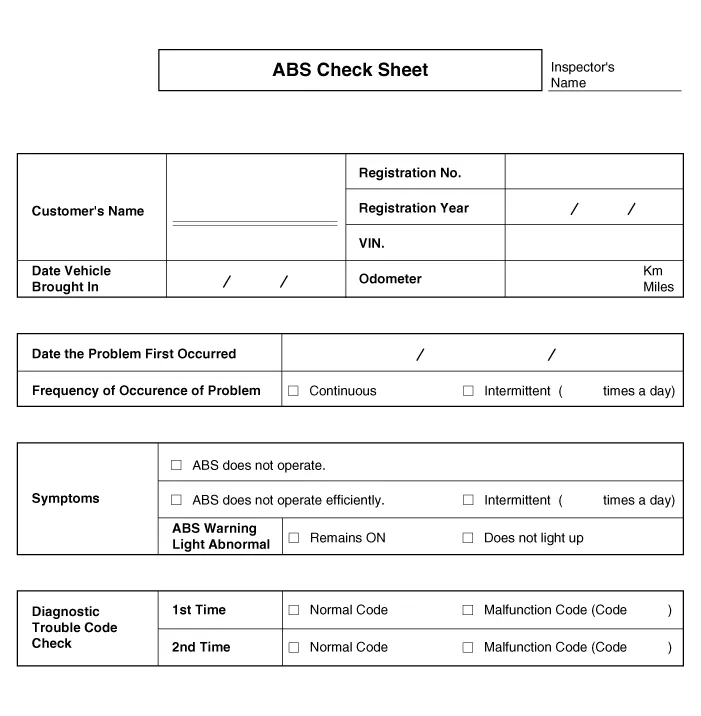
| Symptom | Suspect Area | ||||||||
| ABS does not operate. | Only when 1-4 are all normal and the problem is still occurring, replace the HECU.
| ||||||||
| ABS does not operate intermittently. | Only when 1-4 are all normal and the problem is still occurring, replace the ABS actuator assembly.
| ||||||||
| Communication with GDS is not possible. (Communication with any system is not possible) |
| ||||||||
| Communication with GDS is not possible. (Communication with ABS only is not possible) |
| ||||||||
| When ignition key is turned ON (engine OFF), the ABS warning lamp does not light up. |
| ||||||||
| Even after the engine is started, the ABS warning lamp remains ON. |
|

• During ABS operation, the brake pedal may vibrate or may not be able to be depressed. Such phenomena are due to intermittent changes in hydraulic pressure inside the brake line to prevent the wheels from locking and is not an abnormality.

| Trouble Symptoms | Possible Cause | ||||||||
| Brake operation varies depending on driving conditions and road surface conditions, so diagnosis can be difficult. However if a normal DTC is displayed, check the following probable cause. When the problem is still occurring, replace the ABS control module. |
|
1.Connect the GDS with the data link connector and turn the ignition switch ON.
2.Verify that the DTC code is output.
3.Is the DTC code output?


1.Disconnect the connector from the ABS control module.
2.Turn the ignition switch ON, measure the voltage between terminal 29 of the ABS control module harness side connector and body ground.
Specification : approximately B+
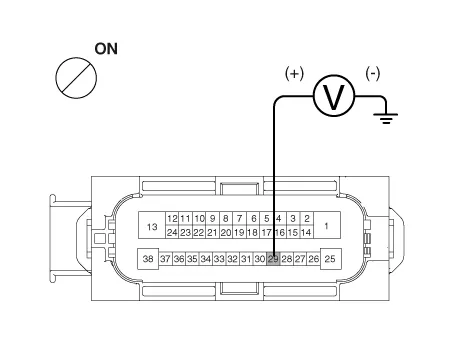
3.Is the voltage within specification?


1.Disconnect the connector from the ABS control module.
2.Check for continuity between terminals 13, 38 of the ABS control module harness side connector and ground point.
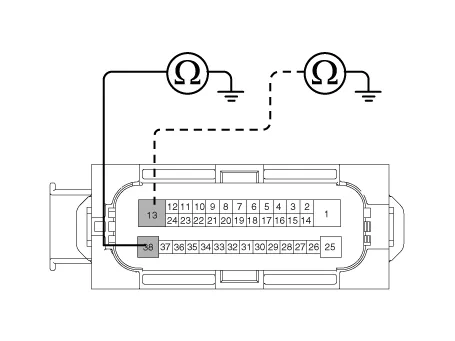
3.Is there continuity?


1.Refer to the DTC troubleshooting procedures.
2.Is it normal?


1.Refer to the hydraulic lines.
2.Inspect leakage of the hydraulic lines.
3.Is it normal?



| Trouble Symptoms | Possible Cause | ||||||||
| Brake operation varies depending on driving conditions and road surface conditions, so diagnosis can be difficult. However if a normal DTC is displayed, check the following probable cause. When the problem is still occurring, replace the ABS control module. |
|
1.Connect the GDS with the data link connector and turn the ignition switch ON.
2.Verify that the DTC code is output.
3.Is the DTC code output?


1.Refer to the DTC troubleshooting procedures.
2.Is it normal?


1.Check that stop lamp lights up when brake pedal is depressed and turns off when brake pedal is released.
2.Measure the voltage between terminal 23 of the ABS control module harness side connector and body ground when brake pedal is depressed.
Specification : approximately B+
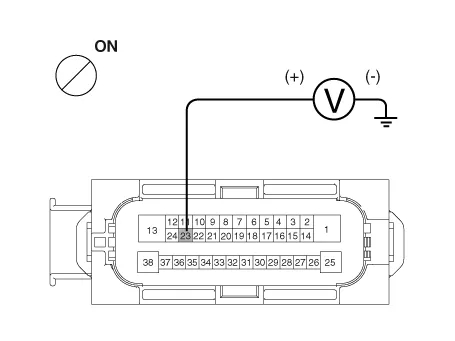
3.Is the voltage within specification?


1.Refer to the hydraulic lines.
2.Inspection leakage of the hydraulic lines.
3.Is it normal?



| Trouble Symptoms | Possible Cause | ||||||
| Possible defect in the power supply system (including ground) for the diagnosis line. |
|
1.Measure the voltage between terminal 16 of the data link connector and body ground.
Specification : approximately B+
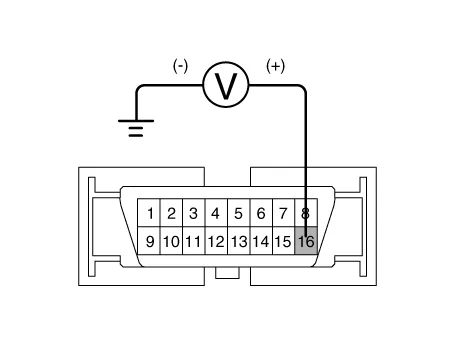
2.Is voltage within specification?


1.Check for continuity between terminal 4 of the data link connector and body ground.
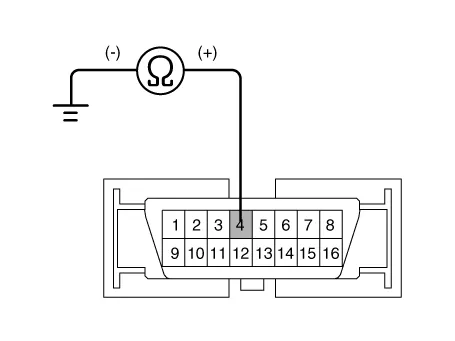
2.Is there continuity?


| Trouble Symptoms | Possible Cause | ||||||
| When communication with GDS is not possible, the cause may be probably an open in the HECU power circuit or an open in the diagnosis output circuit. |
|
1.Disconnect the connector from the ABS control module.
2.Check for continuity between terminals 26, 14 of the ABS control module connector and 3, 11 of the data link connector.
3.Is there continuity?


1.Disconnect the connector from the ABS control module.
2.Turn the ignition switch ON, measure the voltage between terminal 29 of the ABS control module harness side connector and body ground.
Specification : approximately B+
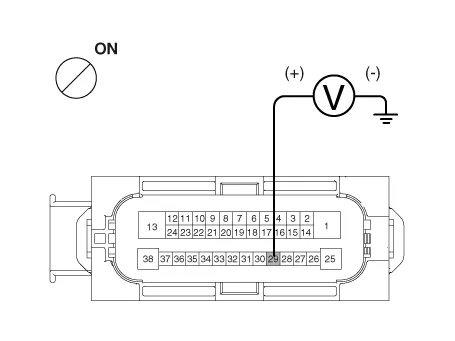
3.Is voltage within specification?


1.Check for continuity between terminal 4 of the data link connector and ground point.


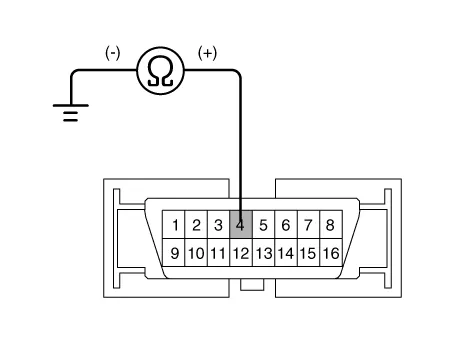

| Trouble Symptoms | Possible Cause | ||||||||
| When current flows in the HECU the ABS warning lamp turns from ON to OFF as the initial check. Therefore if the lamp does not light up, the cause may be an open in the lamp power supply circuit, a blown bulb, an open in the both circuits between the ABS warning lamp and the HECU, and the faulty HECU. |
|
1.Disconnect the connector from the ABS control module and turn the ignition switch ON.
2.Does the ABS warning lamp light up?


1.Disconnect the instrument cluster connector (M08) and turn the ignition switch ON.
2.Measure the voltage between terminal (M08) 39 of the cluster harness side connector and body ground.
Specification : approximately B+
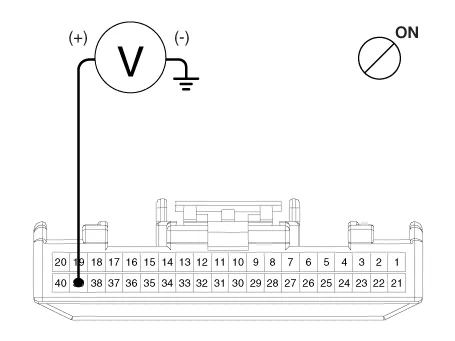
3.Is voltage within specification?


1.Disconnect the instrument cluster connector (M08) and turn the ignition switch OFF.
2.Measure the resistance between terminal (M08) 32 and 33 of the cluster harness side connector.
Specification : 60Ω
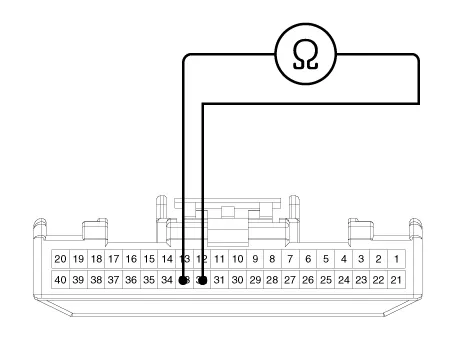
3.Is resistance within specification?


1.Disconnect the instrument cluster connector (M08) and ABS HECU connector, and then turn the ignition switch OFF.
2.Check for continuity between terminal (M08) 32 of the cluster harness side connector and terminal 26 of ABS HECU harness side.Check for continuity between terminal (M08) 33 of the cluster harness side connector and terminal 14 of ABS HECU harness side.
Specification : Below 1Ω
3.Is resistance within specification?



| Trouble Symptoms | Possible Cause | ||||||||
| If the HECU detects trouble, it lights the ABS warning lamp while at the same time prohibiting ABS control. At this time, the HECU records a DTC in memory. Even though the normal code is output, the ABS warning lamp remains ON, then the cause may be probably an open or short in the ABS warning lamp circuit. |
|
1.Connect the GDS to the 16P data link connector located behind the driver's side kick panel.
2.Check the DTC output using GDS.
3.Is DTC output?


1.Disconnect the instrument cluster connector (M08) and turn the ignition switch OFF.
2.Measure the resistance between terminal (M08) 32 and 33 of the cluster harness side connector.
Specification : 60Ω
3.Is resistance within specification?


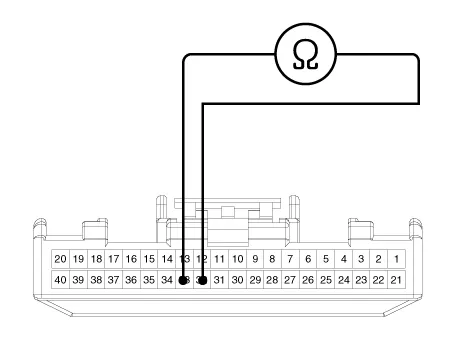
1.Disconnect the instrument cluster connector (M08) and ABS HECU connector, and then turn the ignition switch OFF.
2.Check for continuity between terminal (M08) 32 of the cluster harness side connector and terminal 26 of ABS HECU harness side.Check for continuity between terminal (M08) 33 of the cluster harness side connector and terminal 14 of ABS HECU harness side.
Specification : Below 1Ω
3.Is resistance within specification?


Other information:
Hyundai Accent (HC) (2017 - 2022) Service Manual: Description and Operation
- Description The SMART KEY system is a system that allows the user to access and operate a vehicle in a very convenient way. To access the vehicle, no traditional key or remote control unit is needed.The user carries a SMART KEY FOB which does not require any conscious actions by the user (e.g. operate a RKE button). The SMART KEY system is triggered by pressing a push button in the door handle.Hyundai Accent (HC) (2017 - 2022) Service Manual: Components and Components Location
- Components Connector Pin Information NoConnector AConnector BConnector CConnector DConnector 1Battery (+)Front wiper low backup switch inputStatic bending light (Left)_output-Dedicated DRL output 2RPAS power_outputRear washer switch imput-Key Interlock switch inputTail lamp relay output 3Ignition 1Rear wiper switch inputB-CAN (High)-Power window relay output 4Key IN switchFront wiper switch inputB-CAN (Low)-Front fog lamp relay output 5-Front wiper intermittent volume inputAuto lig
Categories
- Manuals Home
- Hyundai Accent Owners Manual
- Hyundai Accent Service Manual
- New on site
- Most important about car


